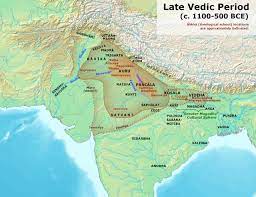The Aryans further moved towards east in the Later Vedic Period. The Satapatha Brahmana refers to the expansion of Aryans to the eastern Gangetic plains.

The royal power had increased along with the increase in the size of kingdom. The king performed various rituals and sacrifices to strengthen his position.
They include Rajasuya (consecration ceremony), Asvamedha (horse sacrifice) and Vajpeya (chariot race). The kings also assumed titles like Rajavisvajanan, Ahilabhuvanapathi, (lord of all earth), Ekrat and Samrat (sole ruler).
Table of Contents
Decline of Social Organisation in Later Vedic Period
The importance of the Samiti and the Sabha had diminished during the later Vedic period.
Economic Condition in Later Vedic Period
Iron was used extensively in this period and this enabled the people to clear forests and to bring more land under cultivation. Agriculture became the chief occupation. Improved types of implements were used for cultivation. Besides barley, rice and wheat were grown. Knowledge of manure was another improvement.
Industrial activity became more varied and there was greater specialization. Metal work, leather work, carpentry and pottery made great progress. In addition to internal trade, foreign trade became extensive.
Foreign Trade
The Later Vedic people were familiar with the sea and they traded with countries like Babylon. A class of hereditary merchants (vaniya) came into existence. Vaisyas also carried on trade and commerce. They organized themselves into guilds known as ganas. Besides nishka of the Rig Vedic period, gold and silver coins like satamana and krishnala were used as media of exchange.
Social Life in Later Vedic Period
The four divisions of society (Brahmins, Kshatriyas, Vaisyas and Sudras) or the Varna system was thoroughly established during the Later Vedic period. The two higher classes – Brahmana, and Kshatriya enjoyed privileges that were denied to the Vaisya and Sudra. A Brahmin occupied a higher position than a Kshatriya but sometimes Kshatriyas claimed a higher status over the Brahmins. Many sub-castes on the basis of their occupation appeared in this period.
In the family, the power of the father increased during the Later Vedic period. There was no improvement in the status of women. They were still considered inferior and subordinate to men. Women also lost their political rights of attending assemblies. Child marriages had become common. According the Aitreya Brahmana a daughter has been described as a source of misery. However, the women in the royal household enjoyed certain privileges.
Religion
Gods of the Early Vedic period like Indra and Agni lost their importance. Prajapathi (the creator), Vishnu (the protector) and Rudra (the destroyer) became prominent during the Later Vedic period. Sacrifices were still important and the rituals connected with them became more elaborate. The importance of prayers declined and that of sacrifices increased. Priesthood became a profession and a hereditary one. The formulae for sacrifices were invented and elaborated by the priestly class.
Therefore, towards the end of this period there was a strong reaction against priestly domination and against sacrifices and rituals. The rise of Buddhism and Jainism was the direct result of these elaborate sacrifices. Also, the authors of the Upanishads, which is the essence of Hindu philosophy, turned away from the useless rituals and insisted on true knowledge (jnana) for peace and salvation.
New modes of disposal of the dead, including the making of elaborate stone structures known as megaliths.
Gahapati
A gahapati was the owner, master or head of a household, who exercised control over the women, children, slaves and workers who shared a common residence. He was also the owner of the resources – land, animals and other things – that belonged to the household. Sometimes the term was used as a marker of status for men belonging to the urban elite, including wealthy merchants.
Important Links